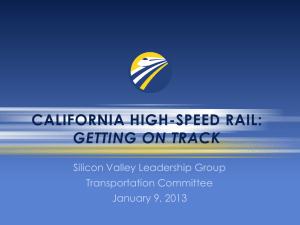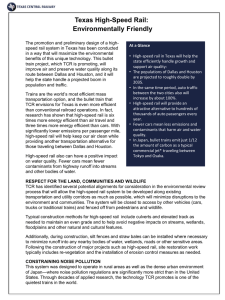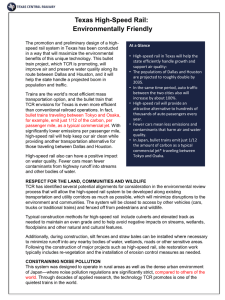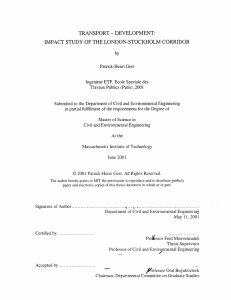California High Speed Rail Authority Power Point
advertisement
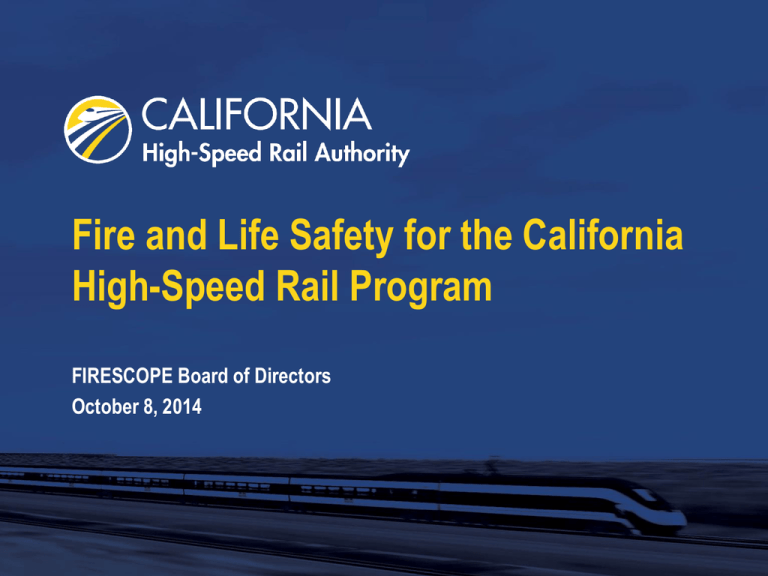
Fire and Life Safety for the California High-Speed Rail Program FIRESCOPE Board of Directors October 8, 2014 THE CALIFORNIA HIGH-SPEED RAIL PROGRAM LARGEST PUBLIC INFRASTRUCTURE PROJECT IN U.S. HISTORY • True High-Speed Trains, 220mph+ • 100% electric power, 25kv overhead contact system • Sealed Corridor – completely grade-separated, fenced for access control • Steel wheel on steel rail • Double-tracked • First phase of approximately 520 miles; 800+ miles when full system is realized 2 THE CALIFORNIA HIGH-SPEED RAIL PROGRAM 3 UPDATE ON THE PROCUREMENT PROCESS • CP01 Madera and Fresno Counties – Contract Awarded in July 2013, full NTP in October 2013 » Final Design has progressed to approximately 60% » Right-of-way acquisition under way – 80 parcels to date » Early activities include surveying, geo-tech investigation, archeological investigation, demolition of structures, clearing/grubbing of land • CP02-CP03 Fresno to Kern County Line: RFP out now, proposals due October with NTP by the end of 2014 4 CP01 – CONSTRUCTION PACKAGE 01 5 CONSTRUCTION PACKAGES 02-03-04 6 FIRE AND LIFE-SAFETY As it relates to the California High-Speed Train System » Passenger safety in the system design » Egress routes in the event of an emergency » Emergency response planning, training, and operations » Fire and smoke prevention and suppression Principle Guidance: NFPA 130 – 2014: Standard for Fixed Guideway and Passenger Rail Systems, with accommodations appropriate for HSR operations 7 FEDERAL RAILROAD ADMINISTRATION • Regulatory authority for the safety of the interstate railroad system in the United States • 49 CFR Parts 200-299 • CPUC has State Safety Oversight authority to enforce FRA regulations and to make their own regulations where FRA is silent 8 OFFICE OF THE STATE FIRE MARSHAL • Authority Having Jurisdiction for fire and life safety considerations of State properties, will issue Permit to Occupy facilities • Goal is a consistent, effective statewide FLS approach • OSFM has made it clear that local authorities must have input to the development of the program in their area • OSFM will provide guidance to local authorities on FLS program of CHSR System • Initial outreach and plan review has begun 9 FIRE & LIFE SAFETY AND SECURITY COMMITTEES • Statewide FLSSC – Meets in Sacramento quarterly to discuss fire & life safety and security issues that affect the CA High-Speed Rail Program on a policymaking level. • Regional FLSSC – Meet quarterly to discuss local plans or characteristics of the CA High-Speed Rail Program and to provide opportunities for outreach and training to local emergency response agencies. » Madera-Fresno Counties » Kings-Tulare-Kern Counties 10 MADERA-FRESNO COUNTY FLSSC TABLE-TOP EXERCISE • April 2014, hosted by Fresno Fire Dept. • 31 participants from 14 agencies » Fresno Fire Dept. » Fresno County Fire Protection District » Fresno County Emergency Medical Services » Office of the State Fire Marshal • Simulated a derailment at the Madera-Fresno County Line » Elevated structure, challenging access » Mass casualty event 11 HAZARD MANAGEMENT PROGRAM • Follows FRA-approved strategy of risk-based hazard management • Conforms to European standard for railway safety known as Common Safety Method • Workshops with discipline-specific technical experts to brainstorm hazards and develop mitigations » Hazard Identification » Hazard Analysis » Development of Mitigation Measures » Acceptance of Residual Risk • Develop draft Certifiable Elements and Hazards Log (CEHL) to carry hazards and required mitigations through all Project phases 12 PASSENGER SAFETY AND SECURITY IN THE SYSTEM DESIGN • Described in Technical Memorandum TM 2.8.1 Safety and Security Design Requirements for Infrastructure Elements for preliminary engineering • Evolving into Design Criteria for the Design/Builders to follow in final design and construction • Typical elements include walkways, stairways, access roads, lighting, tunnel ventilation, signage, access control The key is Prevention through Design 1. 2. 3. 4. 5. 6. 7. Avoidance Elimination Substitution Engineering Controls Warnings Operational Controls Personal Protective Equipment 13 PASSENGER SAFETY AND SECURITY • Emergency management is critical whether an incident is safety or security related • Design elements must not only eliminate or minimize hazards but also support response for any anticipated emergency • Coordinated internal and external response training, drills and exercises, are a significant element in keeping passengers, staff, emergency responders and the public safe 14 EGRESS ROUTES IN THE EVENT OF AN EMERGENCY • • • • Continuous walkway on both sides of the trackway Emergency vehicles access at nominal 2.5 mile intervals, more often if possible Access roads to all tunnel portals and major aerial structures Lighting, communications, water supply, and emergency vehicle staging at emergency access points 15 ACCESS/EGRESS ROADS • • • • Conforms to CFC 2010 as minimum requirements 22 feet wide inclusive of shoulders All-weather surface rated for 75,000# load Dead ends on roads in excess of 150 feet equipped with vehicle turning facility • Minimum outside turning radius 45 feet • Grade not to exceed 10%, except where approved by the local AHJ and OSFM • Gate opening 20 ft min. • Bridges designed for live load of fire apparatus 16 RIGHT-OF-WAY ACCESS • Sealed corridor » Access control barrier (fencing or wall) » Gates or doors at 2.5 mile intervals • Right-of-Way hazards » 25kv overhead contact system » Trains operating at 220 MPH • Train egress » 4 ft. door height above top of rail » Portable ladders/stairs 17 LONG AND TALL STRUCTURES TO MINIMIZE GRADIENT CHANGES 18 ACCESS/EGRESS FOR AERIAL STRUCTURES • Provide level of access/egress to aerial structures comparable to atgrade alignments » » » » » Continuous walkway on both sides of trackway Parapet walls Access to ends of major structures Stairways at nominal 2.5 mile intervals for longer structures Ladder truck access at nominal 2500 foot intervals, preferably from public roadways. 19 LADDER TRUCK ACCESS • Additional emergency access for restricted environments. • Nominal 2500 foot intervals. • Provided from public roads where possible. 20 TUNNELS Pacheco Pass Tehachapi Pass San Gabriel Mtns. 21 POTENTIAL ALIGNMENTS – PALMDALE TO LOS ANGELES 22 TUNNEL FIRE & LIFE SAFETY • Goal - allow passengers to achieve a place of safe refuge » Adjacent bore(s) » Mid-tunnel refuge chamber(s) » Shaft(s) to surface • Walkways, lighting, communication, signage • Cross-passages to other bores • Regular intervals • Ventilated 23 PLACE OF SAFE REFUGE • Goal – Provide tenable environment for passengers and crew while awaiting rescue from tunnel. • Potential places of safe refuge: » Passage to surface – challenging for deep tunnels. » Cross-passage to other running tunnel. » Cross-passage to third bore (service/maintenance tunnel). » Mid-tunnel refuge chamber (capable of accommodating large group of people for extended period of time). 24 TUNNEL VENTILATION FOR SMOKE CONTROL • Air flow pushes smoke longitudinally, away from direction of egress/rescue • Positive pressure protects place of safe refuge • Provides tenable environment for passengers and crew. Will meet the performance goals of NFPA 130 with appropriate accommodations for HSR operations. Safety case to be developed. 25 POTENTIAL FIRE SUPPRESSION AND SMOKE CONTROL STRATEGIES • Primary response - train continues out of tunnel to portal area for evacuation and emergency response. Train in tunnel for minimal period. • On-board fire suppression – high pressure mist system » Interior fires suppressed within trainset compartment, move passengers to other cars. » Exterior fires suppressed with specific systems, 30” fire-rated flooring to protect passengers. • Potential mid-tunnel deluge station for on-board fire where not feasible to remove train from tunnel. • Electrical compartments to have separate suppression systems. Will meet the performance goals of NFPA 130 with appropriate accommodations for HSR operations. Safety case to be developed. 26 OTHER TUNNEL SYSTEMS FOR FIRE LIFE SAFETY AND SECURITY • Fire/smoke detection systems • Suppression system issues » Spot suppression/deluge systems » Standpipe/water supply » Water disposal • Communications • Lighting • Auxiliary power • Rail-borne FLS equipment 27 PORTAL FACILITIES FOR FIRE & LIFE SAFETY AND SECURITY • Surface evacuation and emergency vehicle access/queuing » » » » » » Passenger rescue/assembly area, transfer to other trains or buses Communications, backup power, lighting, water for suppression Access control and intrusion detection Fixed incident command post Ventilation facilities Heli-pad as necessary 28 NEXT STEPS • Continue outreach/communication efforts through established Fire & Life Safety and Security Committees • Specific outreach to local emergency response agencies as requested • Develop fire & life safety program for tunnels 29 THANK YOU • Contact Information » Victor Salazar Safety and Security Manager, CA high Speed Rail Authority victor.salazar@hsr.ca.gov, 916-669-6568 » John Cockle Fire & Life Safety Specialist, Parsons Brinckerhoff, Inc. cocklejl@pbworld.com, 415-243-4762 30
